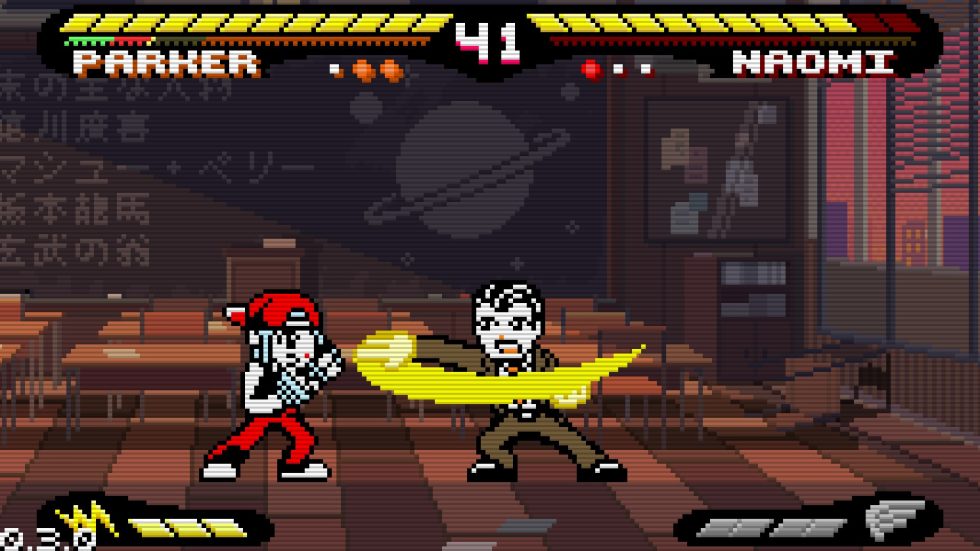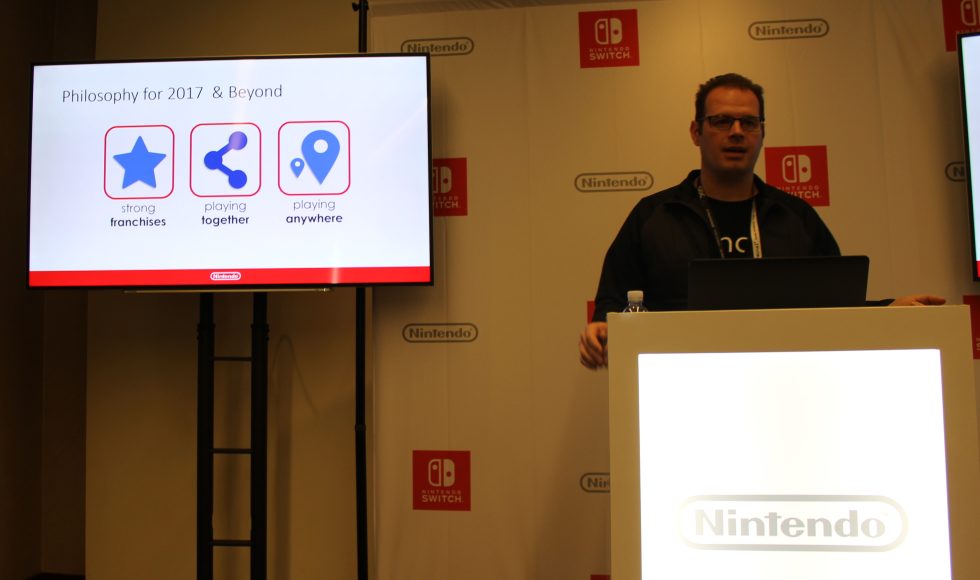SAN FRANCISCO—For many games fans, Nintendo has plenty to prove with its Switch console. The biggest issue, arguably, is the flow of new content. The Wii U stopped receiving games much too quickly from first- and third-party creators. That followed more than a decade of pitiful third-party support for other Nintendo systems.
Executives are insisting—yet again—that this time, Nintendo has got it right. But so far, we've mostly heard about Wii U ports and a spread-thin release schedule. Are we already back to déja vú before the new console is even out?Don't cancel your pre-order yet. In at least one major category, Nintendo just might be getting its act together—and in a giant surprise for longtime Nintendo fans, the company's most promising initiative, and one poised to capitalize on the Switch's strengths, appears to be coming almost entirely from its North American office.
Behold: the Nindies group.
“Every week, new games”
-
The new Nintendo Indies era begins with the blasphemous blood-and-guts adventuring of The Binding of Isaac Afterbirth. This will launch later in March with a full retail package, complete with an instruction manual aping the original Legend of Zelda NES booklet. (This gallery contains more details on the best Nindies games shown at GDC.)
-
My brief demo of Blaster Master Zero felt just as smooth and tough as the NES original. Switch between a side-scrolling, jump-and-shoot tank and a top-down, gun-wielding soldier in an 8-bit alien world. Responsive controls and bright, colorful designs look particularly good on the Switch's 6.2" screen.
-
Graceful Explosion Machine reimagines the Defender-styled space-shooter with multiple unique weapons that all run out of rechargeable ammo quickly. You'll be doing a lot of nimble weapon-switching in order to destroy waves of rasterized aliens. I can see myself losing a lot of time to this slick shooter on the bus with my Switch.
-
Snake Pass recalls the N64 platforming era with some clever modern-physics puzzles that force you to slither your snake around objects in the world. This one's down to a 30fps refresh in both portable and TV modes on the Switch, and I imagine plenty of 3D games will go this route to be anywhere near current-gen visual parity.
-
Celeste by MattMakesGames (of Towerfall fame) will have you reaching your thumb toward the "d-pad" array of buttons on the left Joy-Con. Once you do that, you're in for a clever platformer that makes the most of the Switch's color-preserving screen.
-
Mr. Shifty removes guns from the top-down Hotline Miami formula... and adds warp-through-walls powers (and a satisfying punch through people's faces). This one only reached a 30fps refresh, but it's still a doozy of quick-fire action challenge.
-
Shakedown Hawaii follows the throwback splendor of GTA-styled adventure Retro City Rampage and takes that game's designs and formula into the Neo-Geo era. As much as I loved RCR on the PlayStation Vita, I think I'll get more mileage out of this newer game's new portable home.
-
Tumbleseed has you using both analog sticks to raise and lower each edge of a platform on which your character slides up and down as arranged. You'll have to carefully manipulate this sliding row to avoid enemies and sinkholes—and plant helpful bonuses into the game's "seed" plots. As a bonus, this was the most "HD Rumble"-compatible game on offer, offering distinct, two-handed rumbles based on important gameplay-related elements. Very nice touch.
"This is an opportunity to learn some lessons from Wii U and 3DS," Nindies head partner Damon Baker admits. "I'm happy to say we've addressed a lot of those for Switch."
In short, Nintendo of America's "publisher and developer relations" group has emerged at this year's Game Developers Conference with its strongest and weirdest download-game selection in years, all fueled by individual developers and "indie publishers." What's more, Baker offers a bold promise about the flow of content his group will introduce to the eShop over the next year: "Every week, new games."
Baker looks like the kind of unassuming mid-30s gamer who probably clamored for Super Mario Bros. 3 as a child. He sometimes speaks with the flat delivery you'd expect from a high-ranking Nintendo PR representative. But he takes every opportunity he can to wink and joke while gushing about the recent publishing accomplishments of his team. "Who would've thought we were supporting Binding of Isaac?" he blurts, nodding to Nintendo's implicit endorsement of a blasphemous, violent, and putrid adventure game on Nintendo Switch. (He also enjoys poking fun at Switch promotional materials, often saying, "here's another stock photo!")
His promise of so much content starts with the dozen "Nindies" games that are playable at GDC this year. Pretty much all of them have a "March" or "Spring" release window attached. Nearly every game's demo station at a press event had a developer on hand, and their verdict was loud and clear: the Switch is easy to develop for.
-
The new Blaster Master Zero in portable mode.
-
The new Blaster Master Zero in TV mode.
Many of the game makers on hand declared that Nintendo's documentation for the system is its "best yet." They insist Nintendo has made in-house game engines a cinch to port to the Switch. Brian Provinciano of Retro City Rampage fame has gotten his new game, the 16-bit-era romp of Shakedown Hawaii, running like butter on the Switch. He says that Nintendo, who reached out to him independently about a Switch port, is to blame.
"When you're developing for a new system, good documentation, tools, and resources help you learn the system," Provinciano says. "With your own engine, how to draw a pixel on the screen is different for each system. When the platform [maker] provides you with really good samples on how to do that, you can hit the ground running pretty quickly. On Switch, I got things running fairly quickly."
Other developers of custom-engine games—including Graceful Explosion Machine, Blaster Master Zero, and Pocket Rumble—estimated port times for their existing code bases taking as little as two weeks to run "efficiently" on the Switch. All four of those ran at a locked 60 frames-per-second refresh. Developers using the Unreal and Unity Engine told Ars that their Switch ports took about as long to get running at a reasonable level. They emphasized (as did Baker) that the engine creators have fed developers a steady stream of middleware updates to get the most out of the Switch's metal.
Brawl at the bar

Here's the thing: most of the games at the Nindies showcase ran efficiently and smoothly because they were not visual boundary-pushers. Pocket Rumble, for starters, intentionally looks like a Neo Geo Pocket game, with blocky characters and sub-8-bit color palettes. Charming platformer Celeste (which I gushed about at December's PSX) looks like a Super Nintendo classic. Meanwhile, 3D content like top-down punching game Mr. Swifty and N64-era platformer Snake Pass use limited polygon counts and other simpler rendering techniques.
... meaning, this was a pretty average sampling of quality indie fare. Developers, by and large, have begun shifting away from the "retro for retro's sake" deluge of the Xbox 360 era. They're expending more artistic chops into simpler models and 2D sprites.
This is exactly the kind of content that can pop on the Switch's bright, handsome 6.2" 720p screen in portable mode, not to mention the kind of content that its customized Nvidia Tegra X1 chip can render without breaking a sweat. In one case, the developers of balance-puzzle game Tumbleseed said that they had already built their game to target lower-specced laptops; porting to the Switch only afforded them more headroom.
What's more, Pocket Rumble offered a perfect example of a "Switch on the go" use-case scenario. I asked the developers to remove the system from its TV dock and set it up on a nearby counter, at which point my opponent and I each took a Joy-Con controller, turned it to its side in "SNES" mode, and faced off. (Pocket Rumble is a two-button fighting game, and it will launch with a "d-pad" mode, in which the four face buttons become the d-pad and the shoulder buttons become the attacks. I pretended to play this way for a second, and it felt surprisingly comfortable.)
We had to stand close to the screen, of course, but the screen real estate was enough to easily read. We enjoyed the bright character designs, and I immediately imagined doing this at a bar with a buddy and some beers. (Pocket Rumble's developers quickly remarked, "This mode makes the art look way better than in TV mode." Indeed, color translation on the Switch's built-in panel is mighty fine.)
“Complementary versus competitive”

Nearly every game on show was from an American or Canadian developer, but Baker insists that the company's European and Japanese publishing equivalents are moving forward with their own deals and indie-game advocacy. As an example, the press got an exclusive reveal of "Project Mekeru," an upcoming, Bomberman-like multiplayer game from a Japanese studio whose staff includes former Bomberman game designers.
But Baker didn't mince words: "North America is leading the charge" for independent game-publishing initiatives on the Nintendo eShop. Developers must still be approved, Baker confirms, but he pointed to loosened rules about submission and certification processes, along with "leaked rumors" about affordable Switch dev kits, as dev-friendly efforts that his office is pushing for to get more good games on Switch more efficiently.
He repeated his call to partner with more "indie publishers" on Switch. These kinds of companies included Switch-affiliated outfits like Choice Provisions, Double Fine, Chucklefish, and Team 17. They have proven essential to separating the indie wheat from the underwhelming chaff in a newly crowded indie-games market.

If Baker puts money where his mouth is, Switch could become the ultimate indie-gaming machine. The combination of its indie-friendly tech spec, intelligent "Nindies" curation, and a constant flow of new and unique content would make this a dream device for anybody otherwise overwhelmed by so many indie games coming out. Baker repeatedly pointed to a massive infographic of over 60 upcoming Nindies games, filled with known indie hits like Stardew Valley and new titles like Bit.Trip Runner 3. He announced: "Our philosophy is to look forward, rather than look backwards. Amazing content has come out for other platforms and has already been out there. It might come out eventually on Switch. But our focus for the first few months is on new content and new experiences that make sense for the platform."
Nintendo fans will have a while to wait for brand-new company releases like Arms and Super Mario Odyssey. They'll also likely not see higher-grade, effects-heavy games on their new semi-portable system, and this event didn't assuage those worries (which our own full Nintendo Switch hardware review speaks to). But Baker's team is trying a roundabout route to keep gamers satisfied in the meantime—and to stand out from the rest of the home-system fray. It just might work.
"We've learned the [constant content] lesson from Wii U," Baker says. "We're not launching 32 games on day one. But every week you'll see new content on eShop. And we're taking a complementary stance versus competitive. We think Nintendo Switch is a system for everyone, regardless of whether you own another platform or not. We think this is a perfect fit."
reader comments
51